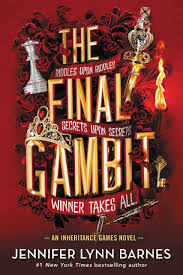
The Final Gambit (The Inheritance Games)
CHAPTER 48
by Barnes, Jennifer LynnThe chapter opens with the discovery of a cryptic pencil sketch on the label of a rare 1973 Chateau Margaux bottle from Tobias Hawthorne’s collection. The drawing depicts a teardrop-shaped crystal, sparking curiosity about its significance. While Grayson initially guesses it might relate to jewelry, the protagonist recalls seeing similar crystals elsewhere and deduces they are part of a chandelier. This realization narrows their search to one of the eighteen crystal chandeliers in Hawthorne House, setting the stage for the next phase of their investigation.
Their search leads them to the Tea Room, where they locate the chandelier in question. The sheer size and complexity of the fixture—with its thousands of delicate crystals—daunts the group. Jameson demonstrates how the chandelier can be lowered for maintenance, allowing them to examine it closely. The tension rises as they contemplate the painstaking task of inspecting each crystal, aware that a single misstep could shatter the fragile pieces and potentially destroy hidden clues.
Working methodically, the trio examines the crystals one by one, their physical proximity underscoring the collaborative yet tense dynamic between them. Grayson spots irregularities in a particular crystal, prompting Jameson to speculate about possible etchings. Grayson, however, hands the crystal to the protagonist, who struggles to decipher any hidden message without tools. This moment highlights the group’s reliance on each other’s strengths and the need for ingenuity to uncover the truth.
The protagonist’s quick thinking leads them to use a flashlight to illuminate the crystal’s irregularities. When the light refracts through the crystal, it projects a chilling warning onto the floor: “DON’T TRUST ANYONE.” This ominous message casts doubt on the alliances within the group and sets a foreboding tone for the chapters to come, leaving readers questioning the motives of every character involved in the mystery.
FAQs
1. What clue led the characters to search for a chandelier in Hawthorne House, and how did they identify the correct one?
Answer:
The clue was found on the back label of a Chateau Margaux 1973 bottle in Tobias Hawthorne’s collection—a pencil sketch of a teardrop-shaped crystal. The protagonist initially considered jewelry but realized they had seen similar crystals on a chandelier. Among the eighteen chandeliers in Hawthorne House, they identified the correct one in the Tea Room by matching the sketched crystal’s shape. Jameson then lowered the chandelier using a wall panel button designed for dusting, allowing them to examine it closely.2. How did the characters decode the hidden message in the crystal, and what was the significance of the warning they discovered?
Answer:
After Grayson noticed irregularities in one crystal, the protagonist used a flashlight to shine light through it. The refracted beam revealed the etched message “DON’T TRUST ANYONE” when projected onto the floor. This warning suggests deeper intrigue or danger within the Hawthorne family dynamics, implying that even close allies may have hidden motives. The method of discovery—using light refraction—highlights Tobias Hawthorne’s penchant for elaborate, multi-step puzzles.3. Analyze the collaborative dynamic between the protagonist, Jameson, and Grayson during the chandelier investigation. What does their teamwork reveal about their strengths?
Answer:
The trio’s teamwork showcases complementary skills: Jameson’s practical knowledge of the house’s mechanisms (lowering the chandelier), Grayson’s attention to detail (spotting the irregular crystal), and the protagonist’s problem-solving intuition (using the flashlight). Their physical proximity (“brushing against each other”) and quick, unspoken coordination reflect growing trust. However, the final warning introduces tension, foreshadowing potential fractures in this collaboration as the mystery unfolds.4. Why might Tobias Hawthorne have chosen a chandelier crystal as the medium for his hidden message, and how does this reflect his character?
Answer:
The chandelier crystal exemplifies Hawthorne’s preference for hiding clues in plain sight—an ornate, everyday object unlikely to draw suspicion. Its fragility (requiring careful handling) and the need for specific tools (flashlight) mirror his complex, layered puzzles. This choice reinforces themes of illusion and perception: just as light refracts through crystal to reveal truth, Hawthorne’s games force characters to “shift perspectives” to uncover deeper realities beneath surface appearances.5. How does the chapter’s final line (“DON’T TRUST ANYONE”) create narrative tension, and what implications might it have for future events?
Answer:
The warning serves as a climactic twist, undermining prior assumptions of safety within Hawthorne House. It raises urgent questions: Is the threat internal (family members) or external? Does it relate to the ongoing mystery or a new danger? The directive’s ambiguity forces readers—like the characters—to reevaluate every relationship. This primes the story for betrayals, moral dilemmas, or psychological warfare, escalating stakes by suggesting that solving puzzles may require questioning allies.
Quotes
1. “I think we’re looking for a chandelier.”
This quote marks a key turning point in the mystery-solving process, where the protagonist connects the clue (a sketched crystal) to a physical object in Hawthorne House, shifting the investigation forward.
2. “Now we take it one by one.”
Jameson’s statement encapsulates the meticulous, detail-oriented approach required to solve Hawthorne’s puzzles, reflecting the methodical nature of the investigation and the family’s problem-solving style.
3. “DON’T TRUST ANYONE.”
The climactic revelation of the chapter, this ominous warning projected through the crystal serves as both a plot twist and thematic statement, casting doubt on all relationships and setting up future conflicts.
4. “Every few minutes, I brushed against Jameson or Grayson, or one of them brushed against me.”
This subtle physical description underscores the tense, intimate dynamic between the characters during their collaborative investigation, hinting at underlying relationships and tensions.
